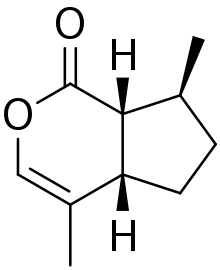Nepetalactone
Nepetalactone is an organic compound, first isolated from the plant catnip (Nepeta cataria), which acts as a cat attractant. Nepetalactone is a bicyclic monoterpenoid, a ten-carbon compound derived from isoprene with two fused rings: a cyclopentane and a lactone (a modified δ-valerolactone ring). It belongs to the class of iridoids. The structure and the effects of the compound are similar to those of valepotriates. A number of isomers of nepetalactone are known.[1]
 | |
 | |
| Names | |
|---|---|
| IUPAC name
4,7-Dimethyl-5,6,7,7a-tetrahydrocyclopenta[c]pyran-1(4aH)-one | |
| Identifiers | |
3D model (JSmol) |
|
| ChEBI | |
| ChemSpider | |
PubChem CID |
|
CompTox Dashboard (EPA) |
|
| |
| |
| Properties | |
| C10H14O2 | |
| Molar mass | 166.220 g·mol−1 |
Except where otherwise noted, data are given for materials in their standard state (at 25 °C [77 °F], 100 kPa). | |
| Infobox references | |
Nepetalactone was first reported in 1941 after it was isolated by steam distillation of catnip.[2]
The compound is also present in the wood of tartarian honeysuckle (Lonicera tatarica), shavings of which are often used in cat toys.
Effects on animals
4aα,7α,7aα-Nepetalactone is the active isomer in Nepeta cataria and has a characteristic effect on cats. Around 67–80% of cats are affected.[3][4] Susceptibility is gene-linked. The chemical interacts as a vapor at the olfactory epithelium.[5]
Nepetalactone has effects on some insects: it repels cockroaches and mosquitos.[6][7]
References
- Robert B. Bates and Carl W. Sigel (1963). "Terpenoids. Cis-trans- and trans-cis-Nepetalactones". Experientia. 19: 564.
- Samuel M. McElvain, R. D. Bright and P. R. Johnson (1941). "The Constituents of the Volatile Oil of Catnip. I. Nepetalic Acid, Nepetalactone and Related Compounds". J. Am. Chem. Soc. 63 (6): 1558–1563. doi:10.1021/ja01851a019.
- "Catnip (Nepeta cataria) – Everything You Need to Know About Catnip!". Cat-World.com.au. Cat World. 2014. Archived from the original on 2015-02-06. Retrieved 2015-01-02.
- Turner, Ramona (May 29, 2007). "How does catnip work its magic on cats?". Scientific American. Retrieved February 14, 2009.
- Hart, Benjamin L.; Leedy, Mitzi G. (July 1985). "Analysis of the catnip reaction: mediation by olfactory system, not vomeronasal organ". Behavioral and Neural Biology. 44 (1): 38–46. doi:10.1016/S0163-1047(85)91151-3. PMID 3834921.
- Kingsley, Danny (September 3, 2001). "Catnip sends mozzies flying". ABC Science Online. Retrieved 2009-02-14.
- "The Cats Might Bite Harder Than the Mosquitoes". ENS / Ameriscan. August 28, 2001. Retrieved 2012-09-01. (scroll down page to last article)